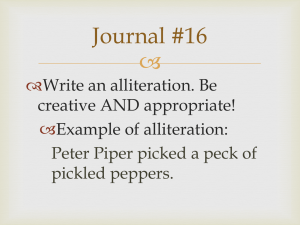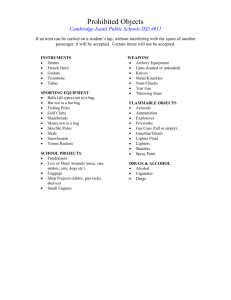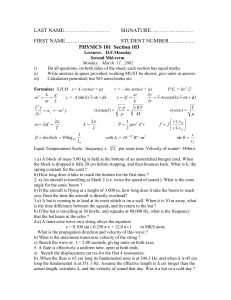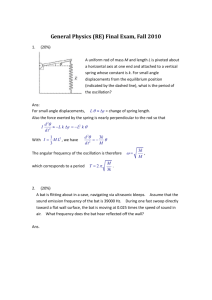Answer to Wind Instrument homework
advertisement
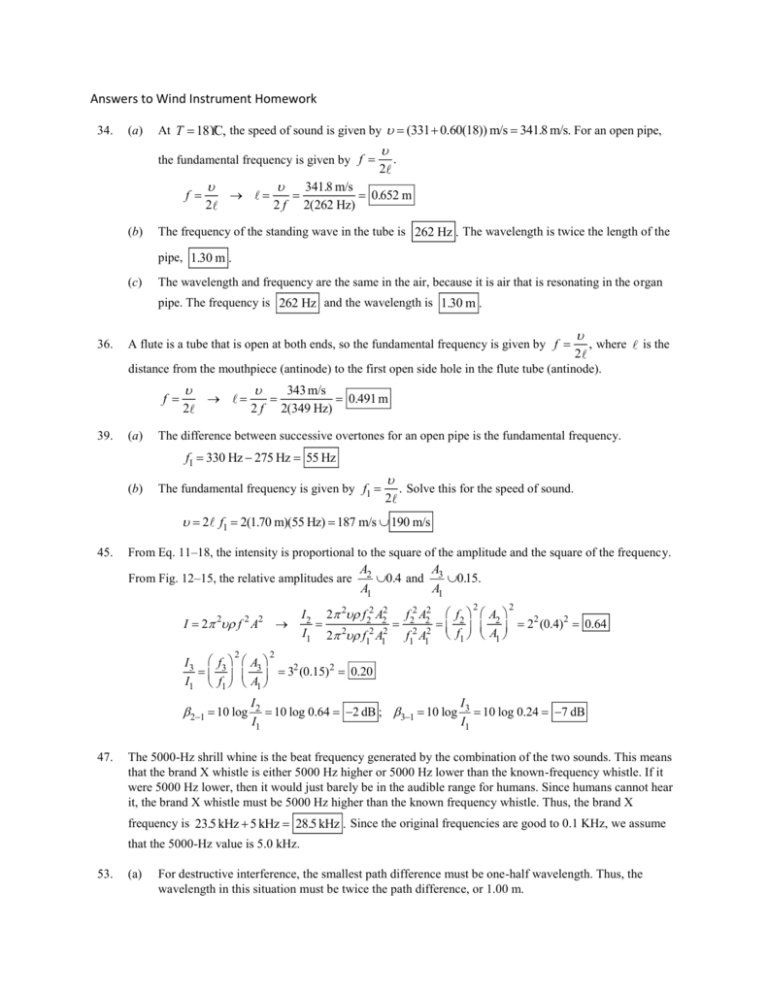
Answers to Wind Instrument Homework 34. (a) At T = 18°C, the speed of sound is given by u = (331+ 0.60(18)) m/s = 341.8 m/s. For an open pipe, the fundamental frequency is given by f = f = (b) u = ® 2 u 2f = u 2 . 341.8 m/s = 0.652 m 2(262 Hz) The frequency of the standing wave in the tube is 262 Hz . The wavelength is twice the length of the pipe, 1.30 m . (c) The wavelength and frequency are the same in the air, because it is air that is resonating in the organ pipe. The frequency is 262 Hz and the wavelength is 1.30 m . 36. A flute is a tube that is open at both ends, so the fundamental frequency is given by f = , where 2 distance from the mouthpiece (antinode) to the first open side hole in the flute tube (antinode). f = 39. u (a) u 2 = ® u 2f = is the 343 m/s = 0.491 m 2(349 Hz) The difference between successive overtones for an open pipe is the fundamental frequency. f1 = 330 Hz - 275 Hz = 55 Hz (b) The fundamental frequency is given by f1 = u 2 . Solve this for the speed of sound. u = 2 f1 = 2(1.70 m)(55 Hz) = 187 m/s » 190 m/s 45. From Eq. 11–18, the intensity is proportional to the square of the amplitude and the square of the frequency. A A From Fig. 12–15, the relative amplitudes are 2 » 0.4 and 3 » 0.15. A1 A1 2 I = 2p ur f A 2 ® 2 2 2 2 I 2 2p 2ur f22 A22 f22 A22 æ f2 ö æ A2 ö = = = = 22 (0.4) 2 = 0.64 I1 2p 2ur f 2 A2 f 2 A2 çè f1 ÷ø çè A1 ÷ø 1 1 1 1 2 I3 æ f3 ö æ A3 ö = = 32 (0.15) 2 = 0.20 I1 çè f1 ÷ø çè A1 ÷ø b 2-1 = 10 log 47. I2 I = 10 log 0.64 = -2 dB ; b3-1 = 10 log 3 = 10 log 0.24 = -7 dB I1 I1 The 5000-Hz shrill whine is the beat frequency generated by the combination of the two sounds. This means that the brand X whistle is either 5000 Hz higher or 5000 Hz lower than the known-frequency whistle. If it were 5000 Hz lower, then it would just barely be in the audible range for humans. Since humans cannot hear it, the brand X whistle must be 5000 Hz higher than the known frequency whistle. Thus, the brand X frequency is 23.5 kHz + 5 kHz = 28.5 kHz . Since the original frequencies are good to 0.1 KHz, we assume that the 5000-Hz value is 5.0 kHz. 53. (a) For destructive interference, the smallest path difference must be one-half wavelength. Thus, the wavelength in this situation must be twice the path difference, or 1.00 m. f = (b) 56. (a) u 343 m/s = = 343 Hz l 1.00 m There will also be destructive interference if the path difference is 1.5 wavelengths, 2.5 wavelengths, etc. D = 1.5l ® l = 0.50 m = 0.333 m ® 1.5 D = 2.5l ® l = 0.50 m = 0.20 m ® 2.5 u 343 m/s = = 1029 Hz » 1000 Hz l 0.33 m u 343 m/s f = = = 1715 Hz » 1700 Hz l 0.20 m f = Observer moving toward stationary source: æ u ö æ 30.0 m/s ö f ¢ = ç 1+ obs ÷ f = ç 1+ (1650 Hz) = 1790 Hz 343 m/s ÷ø è è usnd ø (b) 59. Observer moving away from stationary source: æ u ö æ 30.0 m/s ö f ¢ = ç 1- obs ÷ f = ç 1(1650 Hz) = 1510 Hz 343 m/s ÷ø è è usnd ø The wall can be treated as a stationary “observer” for calculating the frequency it receives. The bat is flying toward the wall. fwall ¢ = f bat 1 æ u bat ö ç 1- u ÷ è snd ø Then the wall can be treated as a stationary source emitting the frequency fwall ¢ and the bat as a moving observer, flying toward the wall. æ u ö æ u bat ö (u + u bat ) 1 f bat 1+ = f bat snd ¢¢ = fwall ¢ ç 1+ bat ÷ = f bat ç ÷ æ u bat ö è usnd ø (usnd - u bat ) è usnd ø ç 1- u ÷ è snd ø = (3.00 ´ 104 Hz) 343 m/s + 6.0 m/s = 3.11´104 Hz 343 m/s - 6.0 m/s Don’t do #63!!! 64. We represent the Mach number by the symbol M. (a) M= (b) M= uobj usnd uobj usnd ® uobj = Musnd = (0.33)[(331 m/s) + 0.60(24)] = 113.98 m/s » 110 m/s ® usnd = uobj M = æ 1 m/s ö 3000 km/h = 967.7 km/h ç = 270 m/s 3.1 è 3.6 km/h ÷ø



